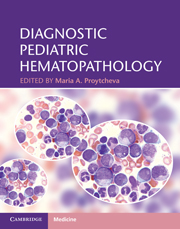Book contents
- Frontmatter
- Contents
- List of contributors
- Acknowledgements
- Introduction
- Section 1 General and non-neoplastic hematopathology
- Section 2 Neoplastic hematopathology
- 10 Chromosome abnormalities of hematologic malignancies
- 11 Expression profiling in pediatric acute leukemias
- 12 Myeloproliferative neoplasms
- 13 Myelodysplastic/myeloproliferative neoplasms
- 14 Myelodysplastic syndromes and therapy-related myeloid neoplasms
- 15 Acute myeloid leukemia and related precursor neoplasms
- 16 Hematologic abnormalities in individuals with Down syndrome
- 17 Precursor lymphoid neoplasms
- 18 Advances in prognostication and treatment of pediatric acute leukemia
- 19 The effect of chemotherapy, detection of minimal residual disease, and hematopoietic stem cell transplantation
- 20 Pediatric small blue cell tumors metastatic to the bone marrow
- 21 Pediatric mature B-cell non-Hodgkin lymphomas
- 22 Pediatric mature T-cell and NK-cell non-Hodgkin lymphomas
- 23 Hodgkin lymphoma
- 24 Immunodeficiency-associated lymphoproliferative disorders
- 25 Histiocytic proliferations in childhood
- 26 Cutaneous and subcutaneous lymphomas in children
- Index
- References
10 - Chromosome abnormalities of hematologic malignancies
A practical guide to cytogenetic analysis
from Section 2 - Neoplastic hematopathology
Published online by Cambridge University Press: 03 May 2011
- Frontmatter
- Contents
- List of contributors
- Acknowledgements
- Introduction
- Section 1 General and non-neoplastic hematopathology
- Section 2 Neoplastic hematopathology
- 10 Chromosome abnormalities of hematologic malignancies
- 11 Expression profiling in pediatric acute leukemias
- 12 Myeloproliferative neoplasms
- 13 Myelodysplastic/myeloproliferative neoplasms
- 14 Myelodysplastic syndromes and therapy-related myeloid neoplasms
- 15 Acute myeloid leukemia and related precursor neoplasms
- 16 Hematologic abnormalities in individuals with Down syndrome
- 17 Precursor lymphoid neoplasms
- 18 Advances in prognostication and treatment of pediatric acute leukemia
- 19 The effect of chemotherapy, detection of minimal residual disease, and hematopoietic stem cell transplantation
- 20 Pediatric small blue cell tumors metastatic to the bone marrow
- 21 Pediatric mature B-cell non-Hodgkin lymphomas
- 22 Pediatric mature T-cell and NK-cell non-Hodgkin lymphomas
- 23 Hodgkin lymphoma
- 24 Immunodeficiency-associated lymphoproliferative disorders
- 25 Histiocytic proliferations in childhood
- 26 Cutaneous and subcutaneous lymphomas in children
- Index
- References
Summary
Introduction
Chromosomes have attracted many microscopists not only because these sausage-like bodies represent vehicles of genetic material (and hence, are biologically important) but also because they are hypnotically beautiful objects [1].
Chromosomes have captured the interest of scientists for well over 150 years. Initial studies of chromosomes were conducted in plants as early as the mid 1850s. At this time, technical limitations in microscopy and cytogenetic methodology precluded much advancement in the field. The first positive association between a chromosome aberration and a human disorder was made in 1959 when Lejeune and colleagues described trisomy 21 in nine cases of Down syndrome [2]. The first time that a characteristic chromosome change was associated with a specific neoplasm came in 1960 when Nowell and Hungerford identified an abnormally small G-group chromosome [the Philadelphia chromosome number 1 (Ph1)] in cells from patients with chronic myelogenous leukemia [3]. Prior to 1971, identification of each individual chromosome was limited to segregation into seven groups, A through G, using chromosome size and centromere placement as the identifiers. Individual identification of each chromosome was made possible in 1971 by methods developed by Caspersson and colleagues [4]. Using chemical treatment and nuclear dyes, patterns of dark and light areas or “bands” could be visualized along the length of each chromosome.
- Type
- Chapter
- Information
- Diagnostic Pediatric Hematopathology , pp. 185 - 201Publisher: Cambridge University PressPrint publication year: 2011



